On a typical Sunday, you might hear football announcers talk about personnel groupings, such as 12 personnel and 11 personnel. What do these personnel groupings mean?
Personnel groupings are determined by two numbers. The first number represents how many running backs are in the game, and the second number represents the tight ends in the game.
For example, 12 personnel means there is 1 running back and 2 tight ends in the game. 11 personnel means there is 1 running back and 1 tight end in the offensive formation.
This article will show you what personnel means in football and why it’s essential for both the offense and defense.
Personnel Groupings In Football
Personnel groupings are used to indicate the different types of packages a team may use.
Offensive rules indicate the offense may have five eligible players who can catch and run the football.
When talking about personnel groupings, the number only identifies running backs and wide receivers. The remaining number is the wide receivers. For example, 11 personnel means:
1 Running Back + 1 Tight End = 11 Personnel
This means there are 3 wide receivers on the play, as you would subtract the running back and tight end from the total of 5 eligible receivers allowed on the field.
Another common example would be 10 personnel. This is how coaches demonstrate 10 personnel:
1 Running Back + 0 Tight Ends = 10 Personnel
1 Running Back + 0 Tight Ends = 1 Eligible Receiver
Now we know that there is only one running back; it must mean there are four wide/slot receivers on the play.
This knowledge helps defenses match up with offenses from a speed & power standpoint.
We’re going to break down the different formations that come with different personnel groupings.
This will give you a clearer picture of what the offense is trying to accomplish in these personnel sets.
If you’re looking for a more in-depth breakdown, our Ultimate Football Guide breaks down football from a simplistic standpoint.
Running Backs
Personnel groupings are determined by running backs and tight ends. The reason why counting running backs is important is because of the threat of running the football inside of the box.
With more running backs on the field, it means more of a threat to run. This means the defense needs to put more linebackers on the field to play the run. Teams may also put on an extra defensive back if the offense uses their running backs as receivers.
Tight Ends
The reason why offensive personnel groupings are so important is because of the tight end position. When the tight end is in the game, it means there is a greater chance to run the football. Five offensive linemen plus the tight end pose a threat to run power or zone run schemes.
Defensive coordinators will gameplan based on how offensive coordinators use their personnel.
For example, if the opposing offense has a pass-catching tight end who is poor at blocking, they may only run certain plays with him. Defensive coordinators can study those plays and put the appropriate personnel on the field. Each personnel group will typically dictate which set of plays are being run.
If the offense runs multiple tight end sets, it could mean a heavy tendency for run. This is why the defense must sub in big bodies such as defensive linemen or another linebacker.
Learn How To Watch Film Properly…
Uncover your opponent’s offensive and defensive tendencies so you can easily build a game plan.
Inside You’ll Find:
- Strategies to pick apart defenses
- How to identify player weaknesses
- How to save time in your weekly breakdowns
21 Personnel In Football
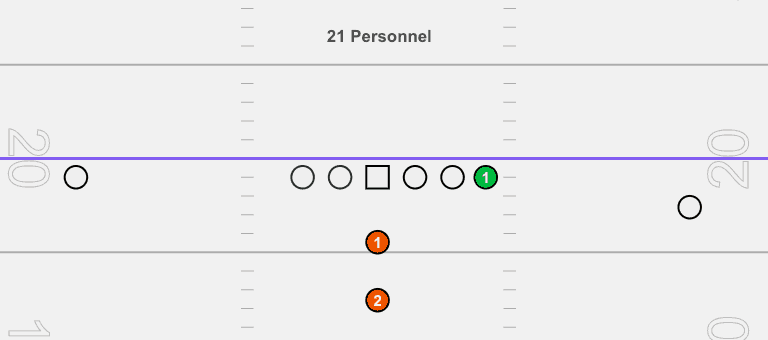
Running Backs: 2
Tight Ends: 1
Receivers: 2
Common Formations: I-Pro, Split Back, Strong/Weak I
21 personnel in football means 2 running backs and 1 tight end.
21 Personnel is a dying personnel grouping, especially in the NFL. With the innovation of the spread offense, fullbacks are not necessarily needed, thus eliminating the second running back.
However, both Kansas City and New England carry fullbacks, proving to be pivotal in their offense, especially in short-yardage situations.
22 Personnel In Football
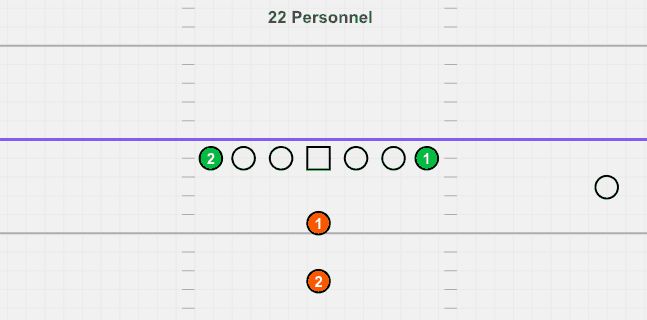
Running Backs: 2
Tight Ends: 2
Receivers: 1
Common Formations: Double Tights I
22 personnel in football means 2 tight ends and 2 running backs.
22 Personnel is often used for short-yardage situations or with teams that have versatile H-backs in their system.
A great example would be when the New England Patriots had Martellus Bennet and Rob Gronkowski on the field simultaneously. Both players match up exceptionally well against linebackers and can block effectively.
As mentioned, 22 personnel have two running backs, two tight ends, and one receiver in the game.
Due to the “bigger” personnel on the field, defenses are more apt to put bigger linemen to match size for size.
10 Personnel In Football
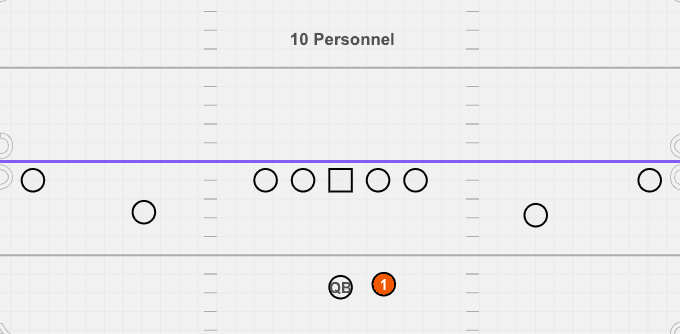
Running Backs: 1
Tight Ends: 0
Receivers: 4
Common Formations: Doubles & Trips
10 personnel in football means 1 running back and 0 tight ends.
10 Personnel is standard for teams that spread the football around the field.
As shown above, doubles and trips are common formations in 10 personnel. Also, typical run schemes of 10 personnel are inside and outside the zone.
Being in 10 personnel is a great way to utilize speed and athletes in space. It also forces the defense to spread themselves out, covering the box with fewer players.
11 Personnel In Football
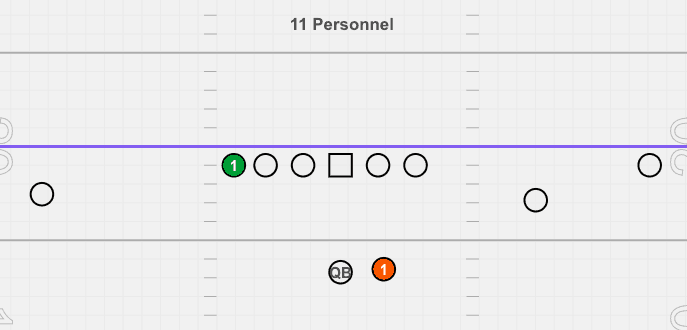
Running Backs: 1
Tight Ends: 1
Receivers: 3
Common Formations: Doubles & Trips
11 personnel in football means 1 running back and 1 tight end.
11 personnel is more balanced for teams to both throw and run from. Teams can still run both inside/outside zone and 21 personnel, plays such as the power.
It keeps offenses more balanced, as they’re forced to keep a linebacker on the field to match the power of the tight end.
Using Rob Gronkowski as an example – he is a matchup nightmare for teams because they have to pick their poison of keeping a linebacker in the game (who is often too slow to run with him) or bringing in a defensive back to cover him (who is often not as good as a linebacker in the run game).
The Patriots have used 11 personnel to run from the spread and attack the middle of the field.
12 Personnel In Football
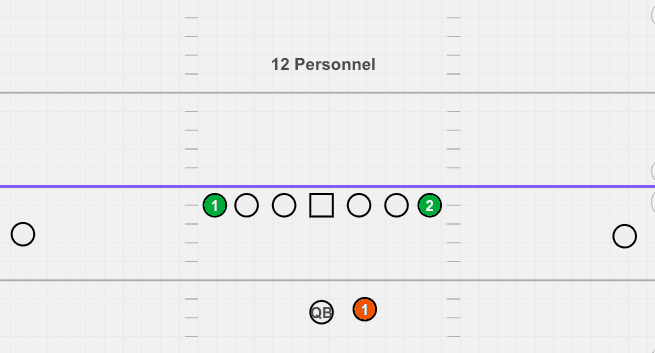
Running Backs: 1
Tight Ends: 2
Receivers: 2
Common Formations: Double Tights
12 personnel in football means 1 running back and 2 tight ends.
12 Personnel is slowly becoming the new 21 personnel for teams who want to run power football but have two tight ends to spare rather than a stalky, physical fullback.
Teams may elect to use two tight ends on the line of scrimmage or one tight end on the line of scrimmage and the other as a motioning H-back.
An example would be running power from 12 personnel, as we diagram here about the power play in our blog.
13 Personnel In Football
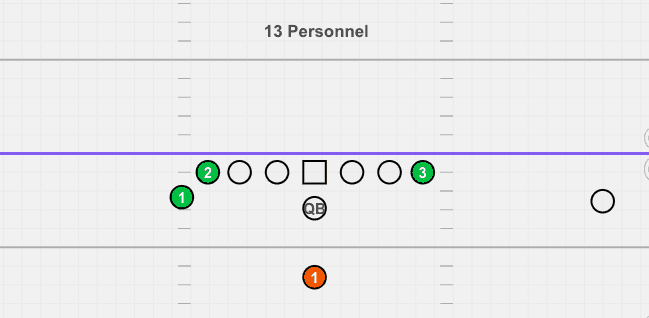
Running Backs: 1
Tight Ends: 3
Receivers: 1
Common Formations: Double Tight Wing
13 personnel in football means 1 running back and 3 tight ends.
Three tight ends are rare in high school and college football; however, at the pro level, it’s common.
We’ll often see Rob Gronkowski, Dwayne Allen, and Jacob Hollister line up tight ends to stick with the New England Patriots theme.
Gronk will often line up as an H-back and motion him back and forth, giving the flexibility to run power or any scheme, often from under center.
13 Personnel is a run-dominant formation and will often warrant defensive coaches to bring in more defensive linemen and linebackers
Why Aren’t The Receivers Included In The Personnel Grouping?
The personnel groupings only include running backs and tight ends.
It makes it easier for defenses to identify using these two positions, as stopping the run is most important to defense personnel.
What If There Are More Than 2 Running Backs?
If there are more than two running backs ( such as a wing T, which has one fullback and two wings), it depends on how the coach wants to classify it.
Because those wings may turn into slot receivers, it may be worth categorizing them as ten personnel. If it’s a dominant run team, it can be classified as 31 or 32 personnel. It’s all at the coaches’ discretion.
What’s The Best Way To Use The Personnel Grouping Numbers?
The best way to utilize the personnel grouping numbers is to determine which defense you should have on the field.
College or pro teams often have a flip board with “21” or “11,” signaling to the defense, which is in the game before the offense breaks the huddle. Certain formations often tip off tendencies of offenses.
Personnel Groupings Recap
If you liked learning about personnel groupings, we have a great course for you. Continue to grow your football IQ with our Ultimate Football Guide below.
You’ll instantly be the smartest in the room after you’ve completed the course.
Now that you’ve learned personnel groupings in football, we recommend you check out our Ultimate Football Guide to greatly enhance your football IQ.


